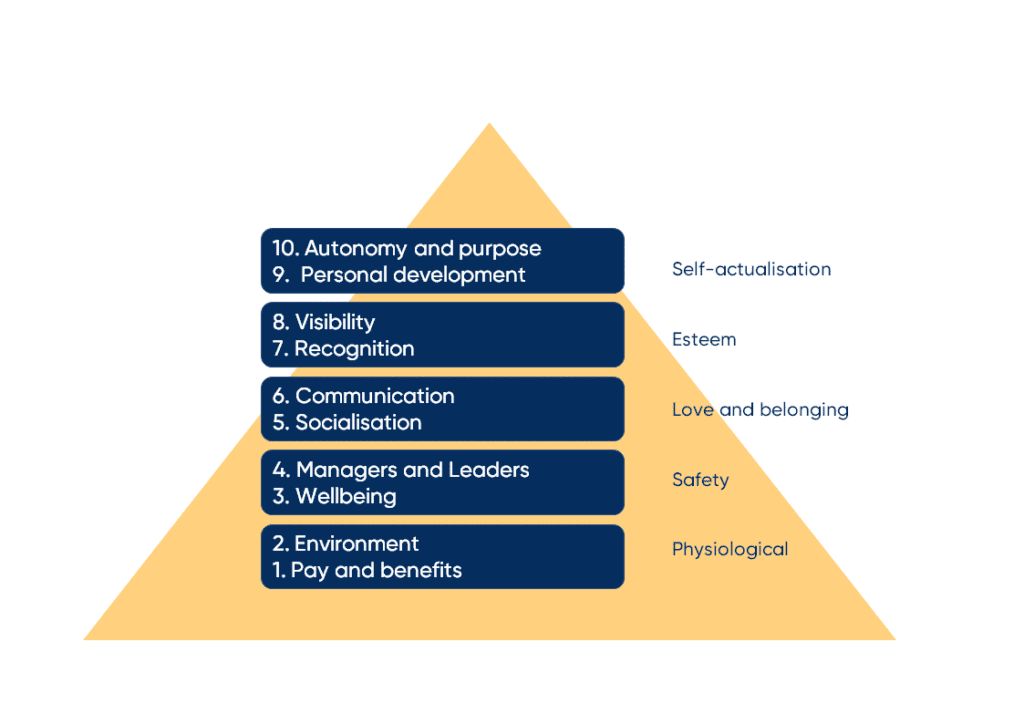To build an engagement-focused culture, it’s crucial that we understand more about the specific elements of engagement. We’ve developed a simple model for engagement based on what HR best practice and behavioral science tells us are the key elements underpinning employee engagement.
How we define employee engagement
The debate rumbles on as to what employee engagement actually is. Even 30 years after William Kahn’s article in the Academy of Management Journal and more than ten years after the 2009 MacLeod Review pointed to more than 50 documented definitions!
Ask HR professionals to describe employee engagement and you’ll hear a range of answers, usually in one of two styles. It’s unsurprising that a 2018 study on CEO views of engagement found that many struggled to define it. That’s why
Here at Zensai, we like to make things simple. So here’s how we define employee engagement:
The level of emotional sentiment and commitment an employee has to their work, their peers, and the company’s goals and purpose.
This gives us measurable variables (affection and commitment) and factors with which to measure against (our work, our employers, their goals/purpose, and our colleagues). Simple really!
How to use our employee engagement model
Our model comes from working with a global clients, some in start-ups and others with 250,000+ employees. It takes the elements of strong employee engagement and arranges them into 5 sub-sections based on Maslow’s Hierarchy of Needs.
It’s important to not take each item’s placement too literally. Although autonomy and purpose appear at the top, they’re not the pinnacle of engagement. These are key parts of the wider picture.
The model’s designed to give you something to reference. You may already be doing some of these well. Focus on other parts of the model for a holistic and strategic approach which should lead to a significant strengthening of engagement across your business.
The order denotes the potential ease of process change from our experience but focus on whichever part of the employee engagement model fits your goals.

The 10 elements of our behavioral model of employee engagement
1. Pay and benefits
While pay and perks aren’t the be-all and end-all of employee engagement, they are objectively the main reason for most employees to seek work. As such this is a key foundation for engagement to grow from.
2. Environment
Beyond the obvious things like health and safety, ergonomic equipment, and basic facilities, effective workplace planning can make a surprising amount of difference in our ability to engage effectively. Yes, even table tennis tables can have their place (sometimes).
3. Wellbeing
Research by Gartner says if your people aren’t feeling right then it can be close to impossible for them to be engaged at work. There are multiple facets to wellbeing: physical, mental, social, financial, and digital.
4. Management and leadership
You know the adage people don’t leave bad companies, they leave bad managers? Well, there is a good amount of truth in that and research by Gartner shows that managers have a huge impact on the engagement of their people. To some extent, leadership is what a company says it will do, while management is what it does do. A lack of connection between these two things must be avoided to model and boost employee engagement.
5. Socialization
In the main, humans are social creatures. So, it should be of no surprise that socialization at work plays a huge role in how engaged employees are.
6. Communication
Arguably the most important focus for most businesses looking to build an engagement-driven organisation is building a culture of open and honest feedback. Closely linked to employee trust, frequent communication throughout a business is essential for great engagement to grow. But what can you do to help managers communicate better with their people? Give them the right tools.
7. Recognition underpins a model employee engagement strategy
Recognition or kudos helps employees see that they are valued, and that their contributions don’t just add to the success of the team but the overall organisation. This is particularly important for growing organisations who want to model best practice employee engagement.
Recognition builds a sense of security and belonging. People feel heard, seen, and valued. Yet most companies cripple their recognition programs with complex structures, workflows and approval processes that hamper people’s ability to just say ‘thank you.’
8. Visibility
We all want to be seen to be doing a good job right? When we feel we have done a great job, but nobody has noticed it, we quickly lose the motivation to try as hard next time. A lack of employee visibility is an engagement killer.
9. Growth and development
Most employees want to develop new skills at work. Learning is a personal investment – it should be owned by individuals, giving them the freedom and resources to learn on their terms. But for a truly engaged workforce, your people and their managers need to take ownership for personal and professional development.
10. Autonomy and purpose
Again, looking at theories of human motivation, both the power to oversee our work and an understanding of where we’re trying to get to are vital. Please, don’t resort to time-tracking software. This goes against everything that progressive managers stand for. Instead, give your people the space to create and complete their work while still providing them with a North Star to follow. This is crucial to developing long-lasting engagement.










